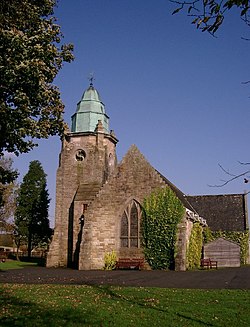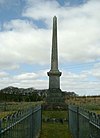Drumclog
| Drumclog | |
| Lanarkshire | |
|---|---|
 Drumclog Memorial Church | |
| Location | |
| Grid reference: | NS639389 |
| Location: | 55°37’29"N, 4°9’42"W |
| Data | |
| Postcode: | ML10 |
| Local Government | |
| Council: | South Lanarkshire |
Drumclog is a hamlet in Lanarkshire, five miles southwest of Strathaven, standing beside the Avon Water, a little before it unites with the Glengavel Water to flow on to Strathaven.
Drumclog is just a mile and a half from the border of Ayrshire to the west. The River Irvine, which flows west into Ayrshire, rises on the border at Drumclog.
The Battle of Drumclog
The Battle of Drumclog was fought on 1 June 1679, between a group of Covenanters and Government forces under John Graham of Claverhouse, at High Drumclog.
The end of the War of the Three Kingdoms and the Restoration of Charles II did not breach between the covenanters and the Crown, and it flared up in 1679. The covenanters summoned a large conventicle at Loudoun Hill, on the boundary of Ayrshire and Lanarkshire on the Lord's Day on 1 June; the minister cut short his sermon at reports that Claverhouse's dragoons were on their way.
The conventicle was half church service half armed camp and from it a group of around 200 armed Covenanters under the command of Robert Hamilton, with 40 cavalry, moved east, to a boggy moor near the farm of Drumclog separated from Claverhouse's men by a bog, or 'stank', which left each advance by Claverhouse bogged down.
After skirmished, the Covenanters pressed the attack. William Cleland led a force around the stank, and advanced rapidly under heavy fire. Claverhouse's line broke, and the dragoons were soon routed from the battlefield, leaving 36 dead.
A somewhat fanciful account of the battle, allegedly written by Thomas Brownlee of the Covenanter army, was published in 1822. Claverhouse himself also left a frank account of the battle. A fictionalised version appears in Sir Walter Scott's novel Old Mortality.
